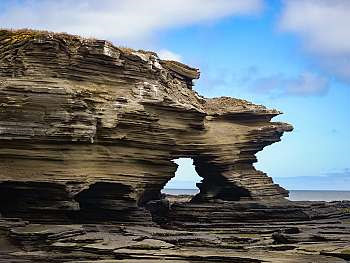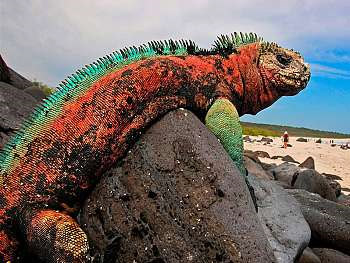
Being one of the smallest countries in Latin America, the Galapagos Islands is a volcanic archipelago in the Pacific Ocean. It is considered one of the world’s foremost destinations for wildlife viewing. A province of Ecuador, it lies about 1,000 kms. off its coast. Its isolated terrain shelters a diversity of plant and animal species, many found nowhere else. Visiting in 1835, Charles Darwin’s observation of Galapagos’ species later inspired his theory of evolution. The Galapagos Islands is a double World Heritage Site protecting both its lands and the surrounding seas. It will keep you in awe and make you wonder how something so small could be so beautiful, diverse and vital to our present-day wildlife and environment.
For information or bookings please contact Janice Snider.
DEPARTURE – Ecuador, Quito | Guayaquil
Your trip starts when your flight departs for Ecuador. On arrival, at Quito or Guayaquil airport you will be met by tour representative, who will arrange the transfer from the airport to the hotel for your pre-night stay in (Quito or Guayaquil).

Arrival – BALTRA AIRPORT – CERRO DRAGON (DRAGON HILL)
Good morning! After breakfast, checkout from the hotel and transfer to the local airport will be arranged to board the flight for Galapagos. Up on arrival at Baltra Airport, you will be met by a cruise representative and transferred to Bonita Yacht. Welcome on board! Settle down and relax, lunch will be served.
After lunch, your first visit is to Dragon Hill which is located in the northwestern area of Santa Cruz Island. It consists of a 1,600 m long trail running through 3 different environments. In 1975, it was one of the only places on Santa Cruz Island where healthy land iguanas (Conolophus Subcristatus) can be found. In the same year, The Galapagos National Park and The Charles Darwin Foundation initiated a program to conserve land iguanas. In the lagoons found here, there are shrimp (Artemia salina), food of the flamingos. At certain times of the year, the shrimp are more abundant and it is one of the reasons for the increasing flamingo population. Afterwards, return to the yacht where a delicious dinner will be served on board.
Meal: Breakfast at hotel, Lunch, Dinner

BUCANERO – ESPUMILLA BEACH – EGAS PORT
After breakfast, we visit Espumilla Beach. It is the main attractions which includes Palo Santo Wood, the beach and the stunning landscape. The beach is a very important site for tortoises as they use this place for nesting. There was a time where the Pigs were the main predatory of tortoise’s eggs hence they were eradicated with the creation of Isabela Project. On the beach you have a chance to do other beach activities like, hike around the shore, paddle board or kayak. After this visit, a delicious lunch will be waiting on board with various other activities.
In evening, you will visit another attraction is Egas Port to visit a beautiful black sand beach. To the south of the beach is the Pan de Azucar Volcano whose volcanic deposits have contributed to the formation of the black sand beach. The crater of this volcano contains a saltwater lake that dries up during hot weather. Between 1928 and 1930, explorations to develop a salt mine were carried out, but it was decided that a mine was not feasible. The workers’ use of endemic woods also damaged the environment and the development was scrapped. Driving to the salt mine is strictly not allowed.
Meal: Breakfast, Lunch, Dinner

ISABELA – FERNANDINA ISLANDS
After a delicious breakfast on board, it’s time to visit Vicente Roca Point at Isabela Island. This is comprised of two separate coves, this site is a large bay with spectacular sea life. Here you can do snorkelling and will be delighted to see seahorses, sea turtles, and the strange yet fascinating Mola-mola (sunfish).
In evening, you board a Panga ride to reach Fernandina Island. It is the third biggest island in the Galapagos and has only one visiting site, Espinoza Point. It is famous for the large colonies of marine iguanas and the home of the flightless cormorant, the Galapagos penguin, snakes and more. From Espinoza Point we can admire the beauty of Fernandina Island and its volcano which last erupted in May 2005. Fernandina is the third biggest island in the Galapagos and has only one visiting site. Fernandina is the only island that doesn’t have mammals and the open areas are extremely fragile. From January to June is the nesting period of the marine iguana, where we take an extra care while walking on the island.
Meal: Breakfast, Lunch, Dinner

ISABELA ISLAND – Urbina Bay | Tagus Cove
After breakfast, your day begins by visiting Urbina Bay. This place is located at the base of Alcedo Volcano between Elizabeth Bay and Tagus Cove. It’s a wet landing place, where the trail length is around 3.20 kms. During a hike we can observe land iguanas, hawks and tortoises. It is also possible to see red and blue lobsters. In afternoon, we will be heading back to ship for buffet Lunch and a short break.
Your afternoon begins by boarding a panga ride to visit Tagus Cove. It is located to the west of the Darwin Volcano on Isabela Island. While walking we will find several inscriptions (names of pirates) dating back to the 1800’s. From here, we can see Darwin Lake, a salt water lake with a depth of approximately 9m. If you want you can do paddle board or kayaking. This lake contains no fish and it is very common to see a variety of bird species. After this trip we go back to the yacht where a delicious dinner will be served.
Meal: Breakfast, Lunch, Dinner

ISABELA ISLAND | MORENO POINT – ELIZABETH BAY
After breakfast on board, we disembark at Moreno Point which is located near Elizabeth Bay on the west coast of Isabela Island. The plethora of birds seen along the striking rocky shores. Here you can hike along a path through lava rock leading to tide pools and mangroves create a birdwatcher’s delight. In the tide pools, green sea turtles or white-tip sharks can be spotted. At noon time, you will be back on board for a short break and lunch.
In evening we visit Elizabeth Bay by a Panga Ride. This is one of the island’s breeding sites for penguins. Located on the west coast of Isabela, Elizabeth Point is a marine visitor site where you can visit Red Mangrove Cove where Brown pelicans, flightless cormorants, spotted eagle rays, golden rays and sea lions are often seen on this island. Overnight on board.
Meal: Breakfast, Lunch, Dinner

ISABELA ISLAND – TINTORERAS | HUMEDALES
After our morning breakfast we start the day by visiting Tintoreras Islet. This small island located in the bay of Puerto Villamil is surrounded by calm turquoise waters. It has an easy trail with great landscapes and very interesting fauna. Along the trail we can see large numbers of Marine Iguanas basking in the sun, lava lizards, herons, gulls and sea lions. In the coves, it is easy to find sea turtles, rays and even penguins. Among the many inlets and channels along the coast, we sometimes see white-tipped reef sharks (in Spanish “Tintoreras”). Following the excursion, we return to the boat for lunch and sail on to our next destination.
Our afternoon will start by visiting hidden the Gem of Isabela “Humedales” translating to Wet Lands and this area is characterized by sandy beaches, rocky shores and mangroves which have an extremely important role in the Galapagos as they provide a nursery for young marine animals as well as a nesting site for birds. Following the various paths, you will find a fabulous destination for bird lovers, pink flamingos and migratory birds including black-bellied and semipalmated plovers, whimbrel, osprey, greater and lesser yellowlegs, Wilson’s phalarope, short-billed dowitcher, common tern, blue-winged teal, just to name a few. You can also observe young giant tortoises from the Isabela Breeding Center.
Meal: Breakfast, Lunch, Dinner

SANTA CRUZ ISLAND – CHARLES DARWIN
After a very early breakfast, luggage and belongings should be ready for checkout. Our last visit for this tour is Charles Darwin Station. It is located in the main port of Santa Cruz Island we will take a private bus to the entrance of the breeding center where we will see tortoises and land iguanas in captivity. This center is the main breeding site on the islands. Animals that were in danger of extinction on various islands are maintained here in captivity. Thanks to the dedicated work of several institutions, some species are being saved. This is where “Lonesome George” lived, the famous last survivor of the species of giant tortoise found on Pinta Island. After this visit, it is now time for you to leave full of good memories of your beautiful vacation. End of services!
Meal: Breakfast